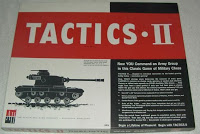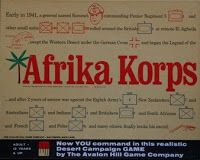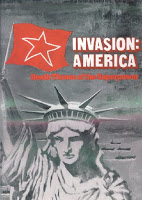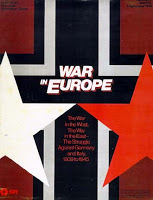There are two uses of the term “grognard” in use in the gaming community today. The first is an old-time wargamer, used to playing either with miniatures (I did Napoleonics in college) or with hex-and-counter wargames. The second is a more general term for people who’ve been playing RPG’s for a very long time (which varies, but generally traces back to at least the 1980’s). Fortunately, I use the term without reservation, as I fall into both categories.
Before I came into RPGing (in fact, before I even knew what an RPG was) and long thereafter, I was an avid wargamer. The late lamented Avalon Hill and SPI game companies produced hundreds of excellent games in every period imaginable. World War II, World War III (in countless different variations), ancients, medieval, science fiction, fantasy; if it had an army on either side, there was probably a hex-and-counter wargame covering the conflict.
 The first wargame I ever played was Tactics II. I discovered it at a friend’s house when I was about 7 or 8 years old, and she and I tried to play. It was pathetic; rolling dice to move the counters like it was Monopoly or something. Finally her older brother took mercy on us and said “you’re playing that wrong.” I promptly borrowed the game, and proceeded to teach myself how to play properly one rule at a time. It was exhausting for someone with no real concept of the genre, especially whose most recent exposure to games was “Don’t Break the Ice”, but I persevered and eventually the world of wargames was laid open to me. I still hold a fondness for the stark simplicity of the rules for Tactics II. It (and the related Tactics and Blitzkreig) really laid the foundations for all the hex-and-counter wargames that followed (even if it did use squares rather than hexes). Zones of control, movement points, supply lines, and that ubiquitous Avalon Hill combat chart that conveniently converted combat strengths into manageable ratios for you. Everything was there. And, I might add, it was ripe for the creation of optional rules, which I produced in force. Some worked, some didn’t. But it was all great fun.
The first wargame I ever played was Tactics II. I discovered it at a friend’s house when I was about 7 or 8 years old, and she and I tried to play. It was pathetic; rolling dice to move the counters like it was Monopoly or something. Finally her older brother took mercy on us and said “you’re playing that wrong.” I promptly borrowed the game, and proceeded to teach myself how to play properly one rule at a time. It was exhausting for someone with no real concept of the genre, especially whose most recent exposure to games was “Don’t Break the Ice”, but I persevered and eventually the world of wargames was laid open to me. I still hold a fondness for the stark simplicity of the rules for Tactics II. It (and the related Tactics and Blitzkreig) really laid the foundations for all the hex-and-counter wargames that followed (even if it did use squares rather than hexes). Zones of control, movement points, supply lines, and that ubiquitous Avalon Hill combat chart that conveniently converted combat strengths into manageable ratios for you. Everything was there. And, I might add, it was ripe for the creation of optional rules, which I produced in force. Some worked, some didn’t. But it was all great fun.
 I bought many wargames once I realized a) that they existed and b) I lived within driving distance of the Compleat Strategist in New York City (wheedling my parents to take me into Manhattan almost every weekend to visit that mecca of gaming, as well as Polk’s Hobbies just around the corner, with its unlimited supply of Atlantic historical miniatures). But Avalon Hill’s Afrika Corps got more of a workout than most. It shared the same sort of simple tactical/operational level rules as Tactics II, but the historical context gave it a depth that the other couldn’t match, and the fact that the opposing forces were unequal, and were constantly changing based on an asymmetrical reinforcement schedule, made it a step up in challenge, forcing me to contend with such things for the first time. Rule of thumb; if the Germans don’t win before the huge Allied reinforcements come in around 1943, they never will.
I bought many wargames once I realized a) that they existed and b) I lived within driving distance of the Compleat Strategist in New York City (wheedling my parents to take me into Manhattan almost every weekend to visit that mecca of gaming, as well as Polk’s Hobbies just around the corner, with its unlimited supply of Atlantic historical miniatures). But Avalon Hill’s Afrika Corps got more of a workout than most. It shared the same sort of simple tactical/operational level rules as Tactics II, but the historical context gave it a depth that the other couldn’t match, and the fact that the opposing forces were unequal, and were constantly changing based on an asymmetrical reinforcement schedule, made it a step up in challenge, forcing me to contend with such things for the first time. Rule of thumb; if the Germans don’t win before the huge Allied reinforcements come in around 1943, they never will. Invasion: America was the first SPI wargame I ever bought (on one of those trips into New York City, along with my best friend Tom, who bought World War 3 at the same time). Here was something a little different; a lot more special rules, much more complex scenarios, and once again my wee brain seemed to simply leap at the challenge. Here were the beginnings of randomized-strength units (the US militia units, which would usually get placed along the landing zones on the coast; what fun when some of them turned out to have a combat strength of zero) and, perhaps most importantly, multi-player capability. You could have up to four players; three of them (the Pan Asiatic League, European Socialist Union, and South American Union) ganging up on the good ol’ USA and Canada. I was especially taken by the designer’s notes; here, finally, was an insight into the mind of the folks who were actually creating these games I loved so much. A subscription to the SPI magazine (and game-of-the-month) Strategy and Tactics soon followed, as did a ton of SPI titles like Next War, Prestags, Sinai, Revolt in the East, and…
Invasion: America was the first SPI wargame I ever bought (on one of those trips into New York City, along with my best friend Tom, who bought World War 3 at the same time). Here was something a little different; a lot more special rules, much more complex scenarios, and once again my wee brain seemed to simply leap at the challenge. Here were the beginnings of randomized-strength units (the US militia units, which would usually get placed along the landing zones on the coast; what fun when some of them turned out to have a combat strength of zero) and, perhaps most importantly, multi-player capability. You could have up to four players; three of them (the Pan Asiatic League, European Socialist Union, and South American Union) ganging up on the good ol’ USA and Canada. I was especially taken by the designer’s notes; here, finally, was an insight into the mind of the folks who were actually creating these games I loved so much. A subscription to the SPI magazine (and game-of-the-month) Strategy and Tactics soon followed, as did a ton of SPI titles like Next War, Prestags, Sinai, Revolt in the East, and…
 War in Europe. The quintessential monster-game that set the stage for all the rest. It was actually a combination of two monster-games in their own right; War in the West and (predictably) War in the East. They eventually came out with an expansion/companion game that covered World War I. This thing was indeed immense. A map of Europe that measured maybe 6′ x 6′. Units were usually divisions, but some Russian corps and other regiments and brigades were represented as well. Rail movement, production (with those wonderfully psychedelic production spiral charts), an abstract air war both tactical and strategic, special rules for all sorts of units, really involved supply rules, political effects (one of the things Germany would always do is overrun a few extra small countries to bring Spain and Turkey into the war), having to juggle a vast array of forces on multiple fronts… This was not a game to either learn or play in an afternoon. My friend Tom dismantled his electric train set so we could set the map up in his basement and play over the course of a couple of months. I would alternately have it set up for months on end in my (really large) bedroom, or set it up on the wall and keep the counters up using blu-tac (which worked remarkably well until the day the map fell down and my floor was covered with German divisions). We played this all the time, not only the campaign but also the smaller scenarios (most of which centered on the Eastern Front, unsurprisingly). A true classic of the genre.
War in Europe. The quintessential monster-game that set the stage for all the rest. It was actually a combination of two monster-games in their own right; War in the West and (predictably) War in the East. They eventually came out with an expansion/companion game that covered World War I. This thing was indeed immense. A map of Europe that measured maybe 6′ x 6′. Units were usually divisions, but some Russian corps and other regiments and brigades were represented as well. Rail movement, production (with those wonderfully psychedelic production spiral charts), an abstract air war both tactical and strategic, special rules for all sorts of units, really involved supply rules, political effects (one of the things Germany would always do is overrun a few extra small countries to bring Spain and Turkey into the war), having to juggle a vast array of forces on multiple fronts… This was not a game to either learn or play in an afternoon. My friend Tom dismantled his electric train set so we could set the map up in his basement and play over the course of a couple of months. I would alternately have it set up for months on end in my (really large) bedroom, or set it up on the wall and keep the counters up using blu-tac (which worked remarkably well until the day the map fell down and my floor was covered with German divisions). We played this all the time, not only the campaign but also the smaller scenarios (most of which centered on the Eastern Front, unsurprisingly). A true classic of the genre.
I could go on for hours about these sorts of games, and there are literally dozens of favorites I haven’t mentioned here. Avalon Hill’s Dune is still probably the best-balanced game I’ve ever played, given that the forces are all completely asymmetrical in abilities. Diplomacy goes without saying, and Kingmaker also saw its fair share of play late into the night. Among the hundreds that graced my shelf were Fulda Gap, Next War, Mechwar, Squad Leader, Starfleet Battles (and, in my mind, the far superior offering from FASA; their Starship Tactical Combat Simulator– those miniatures were amazing!), OGRE/GEV (which I still play to this day, both counters and minis), and the truly fun Creature that Ate Sheboygan.
Unfortunately, most of the games in my once-vast collection are no more, lost to various moves and the various vicissitudes of time. Every once in a while, as I scan through eBay, I see one of my old favorites and put in a lowball bid, hoping to catch a bargain. Once in a while it works, and I get to revel in a little bit more of my childhood, and reminisce about battles long since past.









Great post. I’ve always thought of grognards as “Tractics guys” or whatever, and I’m just old enough to remember when they freely roamed the Earth. I was morbidly amused to hear 3.x players referred to as “grogs” when I’ve been playing RPGs for 27 years and don’t consider myself one. 🙂
I never did get into historical wargaming, and feel like I missed something pretty fun. Unfortunately, given my experience with fantasy wargaming, I probably would have been better at painting than generalship.
I still have my original copy of Tactics II (I also have less beat up copy). I found the game at a yard sale somewhere around age 8-10.
Later I got into miniatures gaming with Donald Featherstone books and Tractics (passing over D&D as something that didn't make sense to me where Tractics made more sense for my 10 bucks).
Then came my friends birthday party in fall of 1977, and the copy of Basic D&D he got…
Frank
Ah, I remember those Donald Featherstone books well. I found them in a used bookstore for, iirc, $2 each, the complete set.